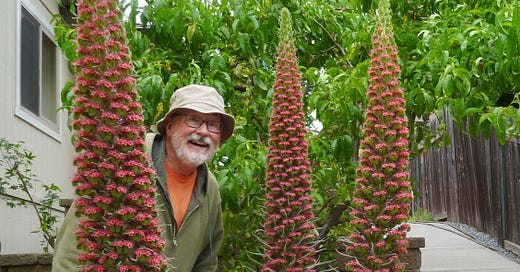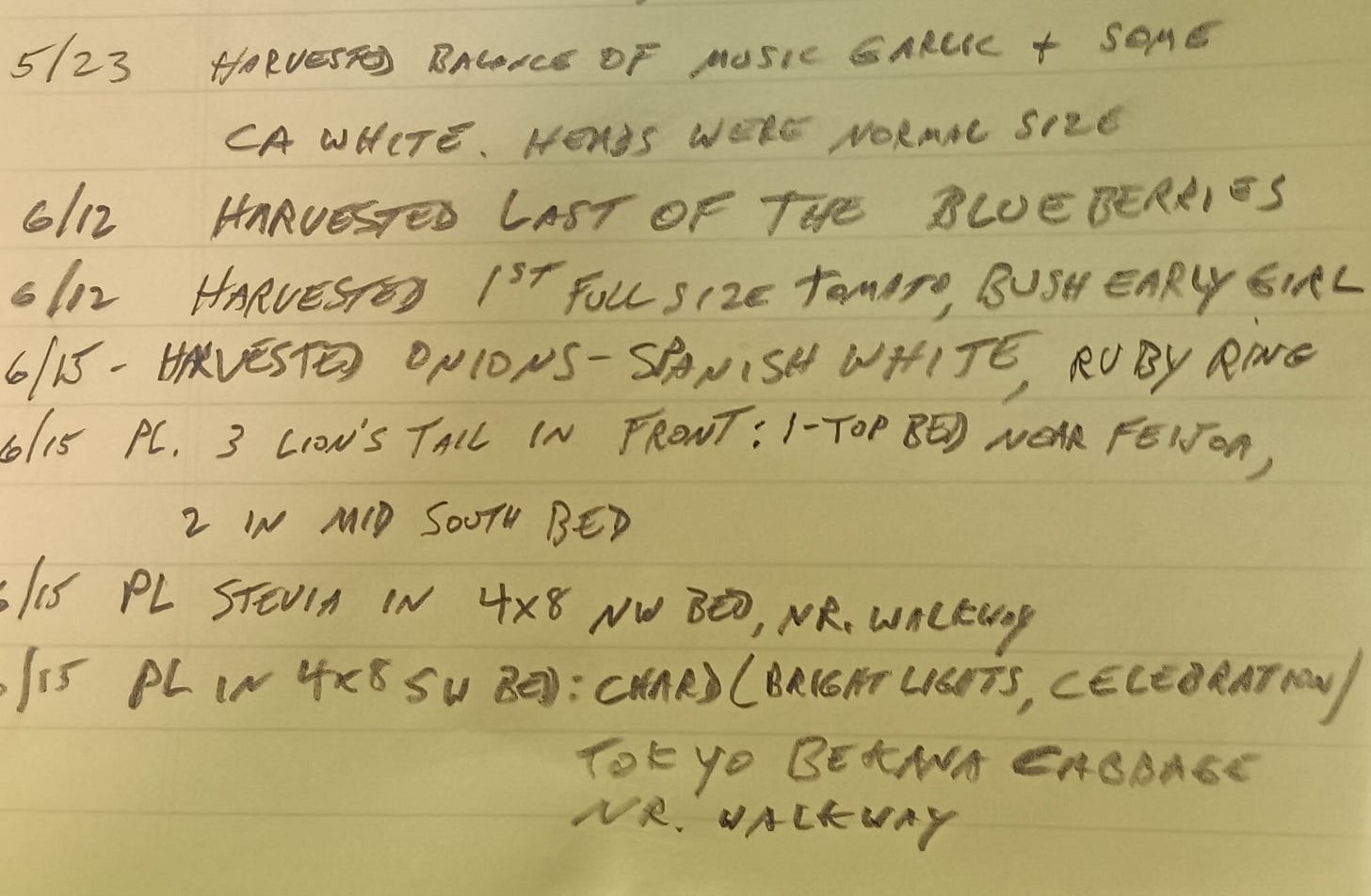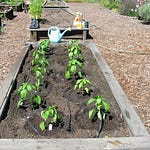The above audio track is from a long time ago, when things were - at the very least -tense. It was during the initial panic as COVID-19 struck the United States, back in May of 2020. The confusion around COVID-19 was my impetus for starting the Garden Basics with Farmer Fred podcast. At that time, there were a lot of people developing a sudden interest in gardening, thinking they might be stuck at home for who knows how long? And, people were stressed. That was my reason for recording the segment (above) for Episode 9 of the Garden Basics podcast. It was all about calming down, and embracing gardening and gratitude.
Maybe we are in another era of high stress now? If you have 5 million people gathering for protests against the government across America in towns and cities large and small - like what happened last week - that answer is fairly obvious.

Participating in last week’s protests did help calm a lot of people across the country. And that’s no outlier. The isolation and stress of the COVID pandemic in 2020 inspired a lot of university research into ways to reduce that stress. One of those studies, recently released, was mentioned in Mike McPhate’s excellent California Sun newsletter recently:
11.
Admiring a flower does a surprising amount of good. (Timothy L Brock)
“A new UC San Francisco study found that so-called micro-acts of joy can have an outsize effect on people’s moods. Researchers had study participants practice seven tasks over seven days, then answer questions about their emotional and physical health. They included: doing a nice thing for a friend, sharing a moment of celebration with someone else, and making a gratitude list. The results were surprisingly robust, said Elissa Epel, a study author. “We were quite taken aback by the size of the improvements to people’s emotional well-being.” S.F. Chronicle”
That study released by the National Institute of Health, has the wonky title: “Scaling a Brief Digital Well-Being Intervention (the Big Joy Project) and Sociodemographic Moderators: Single-Group Pre-Post Study”
We’ll call it the “Big Joy Project” for short. From that study:
Background: Emotional well-being interventions lead to better mental and physical health. However, most of these interventions have been tested on relatively homogeneous samples, with few interventions large enough to examine whether key sociodemographic factors impact outcomes. In addition, barriers to engagement include access and high participant burden. We developed a brief web-based intervention to address these barriers and tested the effects across sociodemographic groups.
Objective: The study aims to examine the effectiveness of a brief, low-burden digital well-being intervention in improving emotional well-being and health-related outcomes across a diverse global sample.
Results: …participants who engaged in more daily practices showed greater improvements. There was a strong pattern of social disadvantage moderating these effects, with groups experiencing greater social disadvantage showing larger benefits across most outcomes. For example, those with lower education, greater financial strain, or lower subjective social status and those identifying as individuals from racial or ethnic minority groups (Black or Hispanic) all showed larger improvements across well-being outcomes. Furthermore, younger people had greater increases in emotional well-being and greater decreases in perceived stress compared to older people.
Conclusions: A brief, low-intensity intervention showed meaningful improvements in well-being and stress, comparable to those seen in longer, more intensive digital well-being interventions.
To quote my long gone Mother: “What does that have to do with the price of tea in China?” Thanks, Mom, for the reminder (I am the king of the scenic bypass, after all). I’ll circle back to gardening…and gratitude.
The Garden Basics podcast began at the same time the ramifications of the Coronavirus epidemic started to hit home. April of 2020. Back then, we were coming to grips with phrases such as “Quarantine in Place” or “Shelter at Home”.
What could you do around the house to keep from going stir crazy? Many of you began gardening for the first time. And that was a good thing for many reasons. You were getting outside. You were moving your body. You were creating beauty. And, you were cultivating gratitude for your new, living creations. You were planting flowers, shrubs, trees, and growing food. You liked it.
Grow Some Gratitude
Since that pandemic five years ago, many of you are continuing to garden. Good for you, you’re cultivating gratitude!
Psychiatrists across the country now are dealing with a lot of disappointment, fear, and burnout. There are steps you can take to help your own mental health.
By working in your garden, you’re cultivating gratitude. And gratitude is good for you. The Harvard Medical School newsletter wrote in 2021: “Gratitude is strongly and consistently associated with greater happiness. Gratitude helps people feel more positive emotions, relish good experiences, improve their health, deal with adversity and build strong relationships.”
One way mental health experts advise to kickstart your gratitude is to keep a gratitude journal. Write down the positive moments of the day, the people and things you saw or interacted with that brought a smile to your face.
As a gardener, keeping a garden diary is a great idea. Not only because it helps you keep track of what you planted, where you planted it, and its success or failure; a garden diary can also be your gratitude journal where you write down about the beautiful flowers, interesting perennials and tasty food that you’re growing. Take a walk through your garden each day. You’ll see a lot to be grateful for: a flower in bloom; the foliage on a tree; the fruit on a shrub; interesting insects (is it a good guy or a bad guy?); even the interesting looking weeds that pop up this time of year.
Plant yourself a gratitude garden plot. Put in plants that you find particularly pleasing or those that have a long blooming or fruiting season in a spot where you can see it easily from inside the house. Outside my office window, I’ve planted flowering maples, the abutilon, the Tiger Eye variety, which produces interesting, red and yellow chinese lantern-shaped flowers that attract the humming birds, year round, here in California. The dense foliage of the plant also attracts other small birds such as finches, that enjoy hopping through the branches. One time, during a live radio show, a bird that we had never seen in our area, a hooded Oriole, paid a visit to the abutilon jungle. The garden conversation between myself and Debbie Flower stopped and immediately turned to scurrying through my bird ID books to identify the bird. We were grateful for the interruption and tickled that the hooded oriole should pay us a visit at that moment.
Besides what you see, don’t forget to be grateful for all that your garden attracts that appeals to your other senses: the aromas of a fragrant plant, such as winter daphne; the pleasant sounds of all the birds and bees that visit; and, the warmth of the sun.
Reminding yourself, every day, what you’re grateful for can boost your mental spirits and help deal with the stress on the ongoing pandemic. And you can cultivate that gratitude with your garden.
Share the Joy
As I mentioned in the podcast at the top of the page, sharing that joy with the neighborhood is one of those “brief, low-burden digital well-being interventions” that is easy for a gardener. Rip out or reduce the size of your front lawn, and put in flowering plants, or perennials, shrubs and trees with interesting structure for all those that walk or drive by your home.
Recently, a car stopped in front of our driveway. A young woman jumped out with a large bag, apparently making a delivery next door. A few minutes passed, and the car, with its engine idling, was still there, with no one in the car. Out of concern (or curiosity), I went outside to see if there was a problem. And there, sprawled on her belly on the sidewalk, the young woman was aiming her IPhone camera for a closeup of a blooming annual I had planted in the narrow strip between the two driveways: a “Zowie Yellow Flame” zinnia.
“Are you OK?” I asked. She jumped up, startled. But happy. “Oh, I love to take pictures of the plants I see while delivering meals,” she said, with a big smile on her face. “I live in an apartment, I wish I had a garden.” I smiled, and said: “Oh, I think you will someday.”
Thank you for also listening to the Garden Basics with Farmer Fred podcast! It’s available wherever you get your podcasts. Please share it with your garden friends. And your subscription to this newsletter helps keep the Garden Basics podcast alive, as well. Thank you for your support.
Fred Hoffman is also a University of California Cooperative Extension Master Gardener in Sacramento County. And he likes to ride his bike(s).
Consider becoming a paid subscriber to help keep this newsletter, as well as the Garden Basics with Farmer Fred podcast alive and well! Thank you.





















Share this post